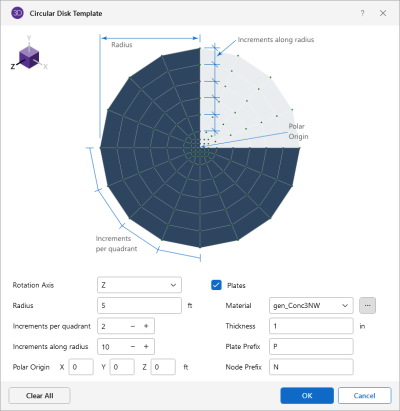Circular Disk Generation
The Circular Disk generation lets you generate a circular disk comprised of plate elements.
Click on image to enlarge it
Circular Disk Template Options
|
Option |
Description |
|---|---|
|
Rotation Axis |
The Rotation Axis defines the axis to which the direction of the circular disk is oriented. |
|
Radius |
The Radius defines the distance from the polar origin to the furthest point on the circular disk. |
|
Increments per quadrant |
The Increment per quadrant defines how many piecewise straight segments are used to model the sweep for each quadrant of the arc. Note: This
entry must be a multiple of 2 (2,4,6, etc.) due to modeling constraints
at the center of the disk. The radius increment specifies how many
“rings” to use to create the grid
|
|
Increments along radius |
The Increments along radius defines the length of increments along the radius. |
|
Polar Origin |
The Polar Origin defines the reference point from which the circular disk height and width are measured and the rotation axis is defined. |
|
Plates |
(checkbox) The Plates option allows you to draw plates between members generated using the Grid Generation. |
|
Material |
The Material option defines the material used to assign properties to the circular disk members. |
|
Thickness |
The Thickness option defines the thickness of the circular disk plates. A Thickness for plates must be defined. |
|
Plate Prefix |
The Plate Prefix defines prefix to plate labels for plates created using the generator. |
|
Node Prefix |
The Node Prefix Defines the prefix used in the node label for each new node generated. |
Specify the polar origin as the point about which the grid rotates and a global axis as the axis of rotation. The grid is generated the full 360 degrees around the axis of rotation.
The radius is total length from the polar origin to the outer edge of the grid. The quadrant increment determines how many piecewise straight segments are used to model the sweep for each quadrant of the arc. Note this entry must be a multiple of 2 (2,4,6, etc.) due to modeling constraints at the center of the disk. The radius increment specifies how many “rings” to use to create the grid.
You must enter a material set and thickness to have plates defined. Only quadrilateral plates are generated. You can also specify labels assigned to the plates.
